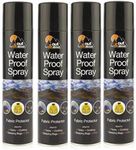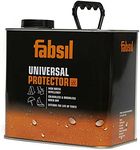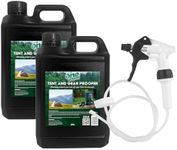Buying Guide for the Best Waterproofing For Tents
Choosing the right tent is crucial for a comfortable and safe outdoor experience. One of the most important aspects to consider is the waterproofing of the tent. Waterproofing ensures that you stay dry and protected from the elements, especially during unexpected rain or wet conditions. Understanding the key specifications related to waterproofing will help you make an informed decision and select the best tent for your needs.Hydrostatic Head RatingThe hydrostatic head rating measures the waterproofness of the tent fabric. It is expressed in millimeters (mm) and indicates the amount of water pressure the fabric can withstand before leaking. A higher rating means better waterproofing. For light rain, a rating of 1000-1500mm is usually sufficient. For moderate rain, look for a rating of 2000-3000mm. For heavy rain or prolonged wet conditions, a rating of 3000mm or higher is recommended. Consider the typical weather conditions you will encounter and choose a tent with an appropriate hydrostatic head rating.
Seam SealingSeam sealing involves applying a waterproof tape or sealant to the seams of the tent to prevent water from seeping through the stitching. This is important because seams are often the weakest point in a tent's waterproofing. Look for tents with factory-sealed seams for the best protection. If you plan to use the tent in very wet conditions, ensure that all seams, including those on the floor and rainfly, are sealed. If you are camping in drier conditions, seam sealing may be less critical, but it still provides added peace of mind.
Rainfly CoverageA rainfly is an additional layer of waterproof fabric that covers the tent, providing extra protection from rain. Full-coverage rainflies extend all the way to the ground, offering maximum protection. Partial rainflies cover only the top portion of the tent, which may be sufficient for light rain but less effective in heavy downpours. Consider the typical weather conditions and choose a tent with a rainfly that offers adequate coverage. If you expect heavy rain, opt for a full-coverage rainfly to ensure you stay dry.
Tent Floor MaterialThe material of the tent floor is crucial for waterproofing, as it is in direct contact with the ground. Look for floors made from durable, waterproof materials such as polyethylene or treated nylon. These materials prevent water from seeping in from the ground. Additionally, check for a bathtub floor design, where the floor material extends up the sides of the tent, creating a barrier against water. If you plan to camp in wet or muddy conditions, prioritize tents with high-quality floor materials and designs to keep the interior dry.
VentilationProper ventilation in a tent helps reduce condensation, which can lead to dampness inside the tent even if the exterior is waterproof. Look for tents with multiple vents, mesh panels, and windows that can be opened to allow airflow. Good ventilation is especially important in humid conditions or when camping with multiple people. If you expect to camp in areas with high humidity or fluctuating temperatures, choose a tent with effective ventilation features to maintain a dry and comfortable interior.















